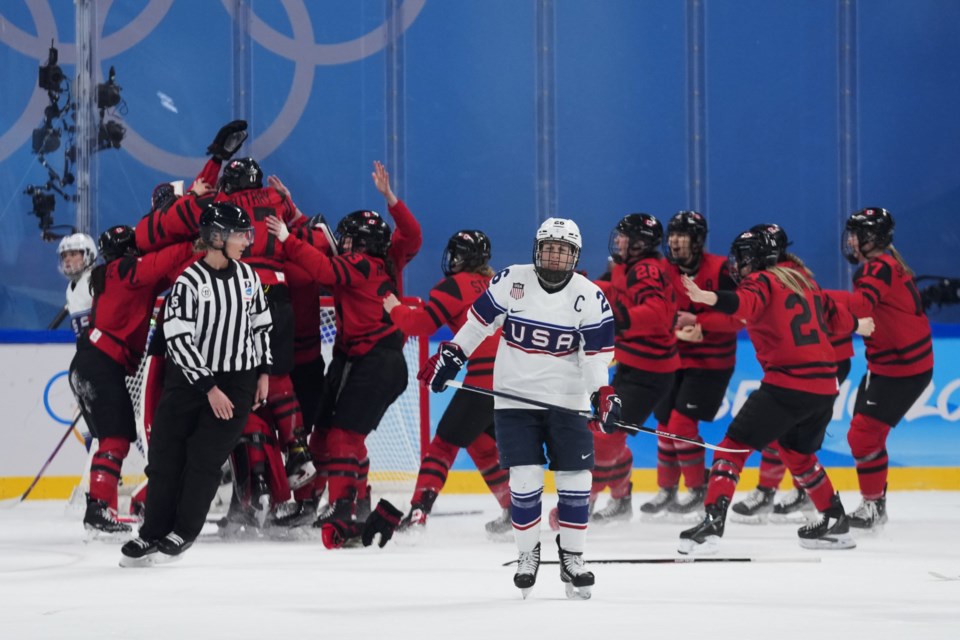BEIJING — Kendall Coyne Schofield's face crumpled behind her mask after the Olympic women's hockey final in Beijing.
The United States captain was asked what the thrilling gold-medal game could do for women's hockey in the future.
"There's a lot of young girls watching back home. Women's hockey cannot be silent after these two weeks," Coyne Schofield said tearfully.¬Ý
Canada edged the U.S. 3-2 for gold in an entertaining championship game, but the 2022 Olympic Games showcased the continued discrepancy of investment in, and commitment to, women's hockey around the world compounded by the COVID-19 pandemic.
Canada outscored its opposition 57-10 in Beijing. The women pushed the envelope largely because of the sweat, pandemic adaptations, time and money invested by its players, coaches and federation.
The economic engines driving men's leagues and tournaments though the pandemic for the last two years weren't there providing the same will in women's hockey.
"The pandemic effectively shut down hockey in many of the women’s European leagues," International Ice Hockey Federation council member Zsuzsanna Kolbenheyer wrote in an email to The Canadian Press.
"This has had a major impact on players preparations. Women‚Äôs league seasons are often shorter than the men‚Äôs, and therefore for many, they did not get a chance to resume their seasons.¬Ý
"For some of these players, it has been a long time since they have played hockey competitively."
Most of Canada's players are without a league and similarly faced pandemic shutdowns.¬Ý
Among their compensations were becoming the fittest they've ever been, using Zoom calls to build an incredible team chemistry and upping their offensive game via virtual chalk talks.
"What Team Canada is showing on the ice right now is really what the game of women's hockey could be on a full-time level," said Daniele Sauvageau, who coached Canada to gold in 2002 and was a broadcast hockey analyst in Beijing.
"The gap is even deeper because Canada did improve since 2018 and the rest of the world continued to do what they used to do, which is not enough."
No other country sent a women's team whose players congregated in July and spend six months together heading into Beijing — not even the United States, which started its residency in October after falling 3-2 in overtime to Canada in the women's world championship final Aug. 31.
European countries prepared their women's teams even less.¬Ý
The abrupt cancellation of April's world championship in Nova Scotia and its rescheduling to Calgary in August put added financial strain on hockey federations also trying to prepare their women's teams for Beijing.
"Some of this money was not recovered due to the suddenness and lateness of the cancellation, and then had to be spent again to prepare teams for August when the tournament was rescheduled," explained Kolbenheyer, who chairs the IIHF's women's committee.
"This was money that would have been spent for Olympic prep. As a result, countries did not spend as much time together leading up to China as they would have."
Bronze medallist Finland, which upset Canada in a world championship semifinal in 2019, lost ground in part because it didn't invest the same time and money in its prep or players as Canada in the months leading into the Winter Games.
"They're always rebuilding because they can't keep players between 22 and 26," Sauvageau said. "They don't have the financial resources to keep them in play. These players have to work, train and play for their club team and manage to do those (national) camps."
The IIHF took considerable heat for the cancellation of January's women's world under-18 championship a second straight year, while its male under-18 counterpart was played in 2021.
President Luc Tardif says the women's tournament will happen in June in the United States.
The lower-division under-18 women's events also called off in Hungary, Austria and Turkey in January will be played this summer in those countries, he added.
Tardif also said the IIHF distributed five million Swiss francs (CDN $6.9 million) in development money to all countries participating in the women's 2022 Olympic tournament and its qualification tournaments, which was an increase of 60 per cent over 2018.
"I'm not the guy who doesn't believe in women's hockey," Tardif said in Beijing.
Canada and the United States may have put the most resources behind their national women's teams among the 10 countries in Beijing, but players going home with gold and silver medals around their necks still face an uncertain future when it comes to a league to play in year-round.
The majority are members of the Professional Women's Hockey Players' Association (PWHPA) that rose from the ashes of the collapsed Canadian Women's Hockey League (CWHL).¬Ý
Pandemic restrictions impeded the showcase games and tournaments they play to drum up support for a league that pays a living wage and provides the competitive supports the male pros get.
So after pouring heart and soul into their Olympic dreams, the North Americans are back to chasing the league they envision.¬Ý
They hope the gold-medal game in Beijing showed the world what that league could be.
"We're hoping that we get the respect that we deserve," Canadian forward Blayre Turnbull said.
This report by The Canadian Press was first published Feb. 18, 2022.
Donna Spencer, The Canadian Press


